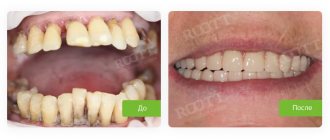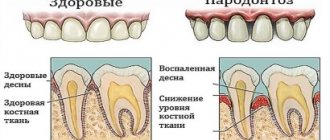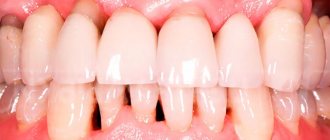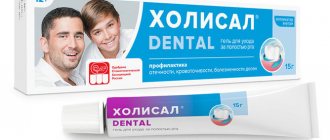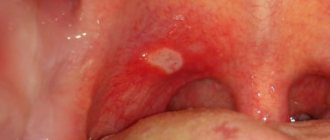Periodontal disease is a chronic disease of the oral tissues that is non-inflammatory in nature. The disease affects the gums, periodontal areas, alveolar processes; characterized by gradual tissue atrophy, which leads to changes in the hard areas of the teeth and exposure of the dental necks.
The difference between periodontal disease and periodontitis is the absence of an inflammatory process. In the first case, inflammation does not develop in the oral cavity, but is present in advanced forms of the disease, when the patient’s immunity is weakened.
Diagnosis of periodontal disease
To identify signs of periodontal disease in adults, the following diagnostic procedures are usually performed:
- inspection;
- probing of the gingival sulcus;
- assessment of tooth mobility;
- X-ray examination (orthopantomography);
- biomicroscopy of the gums to determine the degree of microcirculation impairment.
The patient will also need observation from a general practitioner and endocrinologist to detect and treat general somatic pathology.
After a diagnosis of “dental disease periodontal disease” is made, further examination should be aimed at finding the causes of disturbances in the processes of cellular tissue nutrition, predicting the further development of the disease and the likelihood of inflammatory complications.
Symptoms
Symptoms of periodontal disease can include various indicators. This condition is accompanied by:
- bleeding gums when brushing teeth;
- bad breath;
- loose teeth or changes in their position;
- receding gums;
- swelling or redness of the gums;
- accumulation of plaque and tartar;
- painful sensations while chewing food;
- tooth loss;
- unpleasant taste in the mouth.
In the early period of development of periodontal disease, its symptoms are not very noticeable, so regular examination by a dentist will avoid complications of this disease and stop its further development.
Symptoms of dental periodontal disease
The main symptom of the disease is detected during x-ray diagnosis of periodontal disease. The image shows a uniform decrease in the height of the interdental septa with alternating foci of osteosclerosis and osteoporosis in the deep parts of the alveolar process and the body of the jaw, as well as in other bones of the skeleton. Traditionally, changes are accompanied by the presence of diseases of the cardiovascular or endocrine systems and metabolic disorders.
There are other symptoms of severe periodontal disease that are more noticeable to the patient and others:
- gum retraction;
- exposure of the necks and roots of the teeth;
- pale gum color;
- lesions of teeth of non-carious origin (wedge-shaped defects, hyperesthesia).
Treatment of periodontal disease
Completely curing periodontal disease is not always an easy task for the dentist, especially if the patient seeks medical help late. The exact treatment plan is always selected individually and only after a comprehensive examination. In order to restore the normal anatomy of the dentition, a wide variety of methods can be used, ranging from conservative therapy to surgical intervention.
Drug treatment
Includes the prescription of drugs that improve blood circulation and reduce hypoxia, which promotes bone resorption. Such drugs include:
- Antioxidants. The simplest and most accessible drugs from this group are vitamins E, B, A, C and P. Their mechanism of action is associated with stimulating the process of oxygen delivery to tissues.
- Anabolic steroid. They are usually prescribed to men due to the specific action of such drugs. The dentist may first refer the patient for a consultation with an endocrinologist or therapist to ensure there are no contraindications.
- Vasodilators. The mechanism of their action is based on improving microcirculation, increasing blood flow to periodontal tissues, and preventing capillary thrombosis (this condition develops with periodontal disease).
Other medications may be included in your treatment plan. For example, when inflammation or secondary infection develops, antibacterial and anti-inflammatory drugs are prescribed.
Selective grinding of teeth
The essence of this treatment method is to create normal contact between the teeth on the upper and lower jaw (occlusion). With periodontal disease, tooth enamel can accumulate excess amounts of calcium, as a result of which the physiological wear of teeth slows down. This can lead to the formation of a traumatic bite and fan-shaped divergence of teeth. To avoid this, the enamel on some teeth is ground down, thereby achieving optimal contact between the upper and lower jaw. To protect polished teeth from caries and rapid destruction, they are coated with a special paste.
Splinting mobile teeth
The goal of this treatment method is to securely fixate the teeth, so splinting is carried out in the last stages of periodontal disease. Splinting can be done using artificial crowns or fiberglass, which are installed for varying periods, ranging from 1 month to several years.
Splinting is used not only to fix teeth. It is known that with pathological mobility, the rate of bone tissue atrophy increases significantly, resulting in increased mobility. If no measures are taken, the teeth will diverge in different directions (fan-shaped divergence) and fall out over time.
Treatment of periodontal disease at home
For periodontal disease, traditional treatment methods can also be used. They are usually prescribed in the early stages of diseases. Traditional methods of treatment include rinsing the mouth with decoctions or infusions of herbs that have anti-inflammatory, antimicrobial and reparative effects. It is important to remember that such therapy is auxiliary and is used as a supplement to the main treatment prescribed by the dentist. Therefore, you should not treat periodontal disease yourself at home.
Your doctor may also recommend treatment for periodontal disease, which you can do at home yourself. One such method is gum massage. It can be done either with a toothbrush or just with your finger. It is important to follow the correct technique. Movements should be smooth and careful, coinciding with the direction of the flow of lymphatic fluid. To enhance the therapeutic effect, special gels can be used that improve blood circulation and microcirculation in the gums. Massage should be performed 2 times a day for 3-5 minutes.
Physiotherapeutic treatment
The list of physiotherapeutic procedures prescribed for periodontal disease is very large. The most commonly prescribed physiotherapeutic treatments are:
- Electrophoresis and phonophoresis with heparin. Heparin has a beneficial effect on periodontal tissue. It helps saturate them with oxygen and improve microcirculation. The problem is that delivering heparin to periodontal tissue without the use of additional methods is problematic. Physiotherapy helps in this situation. When exposed to a weak electric current, heparin penetrates more actively into tissues, where it exerts its therapeutic effect. Electrophoresis and phonophoresis are carried out in a course, which includes 10-12 sessions with an interval of 7 days. The duration of one procedure is about 15 minutes.
- Vacuum massage of gums. This method is significantly more effective than conventional massage. The effect of vacuum has an additional stimulating effect on the blood circulation and metabolism. The full course includes 8-12 sessions with a break of 3 to 5 days.
- Laser treatment. It is also used to improve blood circulation, trophism and metabolic processes in periodontal tissues. Treatment is carried out using a special helium-neon laser. To achieve the desired effect, 12-15 procedures are carried out. It is recommended to repeat the course several times a year.
In the treatment of gum periodontal disease, other treatment methods can be used, for example, magnetic therapy, dynamic currents, vibration massage. Their choice is determined by the capabilities of the clinic, since not all institutions have a complete set of all equipment.
Surgery
Various types of operations are usually used in the later stages of periodontal disease or when conservative therapy is ineffective. Surgical treatment is aimed at eliminating periodontal pockets, eliminating all subgingival deposits and removing the connective tissue that replaces the resorbed bone. To achieve these goals the following are used:
- Closed curettage of periodontal pockets. It is carried out with shallow pocket depths. One of the disadvantages of the method is that the dentist has to act “blindly,” therefore, in severe forms of periodontal disease, such treatment can only bring temporary results.
- Open curettage of periodontal pockets. Unlike the previous method, this operation is performed by peeling the gum from the tooth. As a result, the dentist can see the pockets and connective tissue and completely remove all deposits.
- Bone grafting. It is performed to restore resorbed bone. This treatment becomes especially relevant in cases where the patient is indicated for the installation of implants. Bone grafting involves the transplantation of donor bone or synthetic material that has normal density.
All types of surgical treatment of periodontal disease are carried out using high-quality anesthesia, so during the operation the patient does not feel pain or discomfort.
General recommendations
After drawing up a treatment plan, the dentist must give general recommendations. These include:
- Careful adherence to oral hygiene. During treatment of periodontal disease, routine tooth brushing with a toothbrush is not enough. It is necessary to use additional devices - dental floss, brush, irrigator, special pastes, gels and rinses.
- Proper nutrition. For periodontal disease, the diet must contain all the necessary vitamins and minerals, as well as a sufficient amount of proteins, fats and carbohydrates. In this case, the food should be gentle. You need to exclude solid foods, too hot or cold foods from your diet.
- Rejection of bad habits. It is especially important to quit smoking, since the substances contained in tobacco smoke adversely affect the blood supply and trophism of the oral mucosa.
- Sanitation of the oral cavity. This term means the elimination of all associated dental diseases - caries, gingivitis, pulpitis, stomatitis, and so on.
Throughout the entire period of treatment for periodontal disease, it is necessary to monitor the condition of the oral cavity and, if any pathological changes develop, immediately contact a dentist.
Stages of periodontal disease
In modern dentistry, there are three degrees of severity of periodontal disease.
Mild degree
How does periodontal disease begin? In the early stages, the disease occurs without pronounced symptoms with gradual atrophy of the gum edge and bone tissue. With periodontal disease of the anterior teeth, a slight exposure of the dental necks occurs; in some cases, patients experience increased sensitivity of teeth to food irritants (hot and cold, sweet and sour). On X-ray images, the onset of periodontal disease is indicated by the first signs of bone tissue atrophy.
Average degree
With an exacerbation of periodontal disease, not only the necks, but also the roots of the teeth are exposed - by 2 - 3 millimeters. X-ray images show destruction of bone tissue along half the length of the root and the presence of foci of sclerosis.
Severe degree
With severe periodontal disease, exposure of the roots of the teeth reaches 4–5 millimeters, bone tissue atrophy on X-ray photographs covers two-thirds of the root.
Symptoms of the disease
The development of periodontal disease occurs at a fairly slow pace. The disease is accompanied by gradual atrophy of the alveolar processes and dystrophic changes in the bone tissue of the teeth. In this case, the roots are exposed.
Among the symptoms of periodontal disease are the following:
- susceptibility to temperature irritants, sweet and sour foods - all this appears due to the exposure of tooth roots, on which there is practically no enamel,
- pallor of gingival tissues,
- itching and burning in the gums,
- change in the beauty of the smile - the crowns of the teeth become very long. This pathology is usually called “horse smile”,
- Gaps appear between the teeth in the root area,
- teeth become mobile as the tissue around their roots decreases, because it becomes almost impossible to keep them.
If you take an OPTG - a panoramic X-ray image, then the destruction of bone tissue will be clearly visible on it, i.e. its significant loss around the roots. Moreover, throughout the entire dentition, since periodontal disease is rarely localized in the area of one tooth.
Periodontal disease – what to do?
At the initial stage of periodontal disease, you should consult a periodontist. No folk remedies will help get rid of the disease. Only a specialist will be able to carry out the necessary diagnostic procedures and prescribe, based on the identified symptoms of periodontal disease, treatment aimed at slowing down degeneration in periodontal tissues and preventing inflammatory complications. It is also necessary to eliminate non-carious dental lesions and undergo a thorough examination by a therapist to diagnose and treat common diseases that provoke the development of periodontal disease.
Complex therapy of periodontal disease involves the following measures:
- Timely removal of dental plaque.
- Normalization of occlusal relationships (grinding teeth, prosthetics, splinting).
- The use of vitamins and agents that improve microcirculation (nicotinic acid, aloe extract, heparin).
Diagnostics
To determine the presence of periodontal disease and the complexity of its course, you must consult a dentist. The disease is diagnosed by a specialist during a periodontal examination. A dental instrument (probe) is used to carefully measure the groove (pocket or space) between the tooth and gum. A healthy sulcus is three millimeters or less deep and does not bleed. As periodontal disease progresses, the pockets usually deepen.
To establish the correct diagnosis, the dentist examines the mobility of the teeth, the degree of bleeding and inflammation of the gums. After reviewing the patient's medical history, the doctor determines various factors that influenced the development of this disease.
X-ray examination is one of the main stages of diagnosis, since the image will reflect bone loss.
Treatment methods
Methods and procedures used to treat periodontal disease in dentistry:
- exposure to high pressure oxygen in hyperbaric chambers;
- electrophoresis;
- diadynamic currents;
- amplipulse therapy;
- darsonvalization of gums;
- UHF therapy;
- gum massage;
- local hypo- and hyperthermia;
- ultrasound therapy.
Psychosomatics of periodontal disease
Based on the results of many years of research, American scientists have come to the conclusion that dental diseases such as periodontal disease are directly related to high anxiety, depression and an acute sense of loneliness. This is explained by the fact that increased levels of the stress hormone - cortisol - in the blood negatively affect the condition of the gums and jaw bones. In addition, during periods of nervous tension, people begin to pay less attention to oral hygiene and increase the doses of alcoholic beverages, nicotine and medications, which also contributes to the development of various diseases.
Treatment
In the treatment of periodontal disease, the following modern treatment methods are used:
- Surgical.
- Orthopedic.
- Physiotherapeutic.
- Therapeutic.
The best treatment results are achieved when treatment is carried out comprehensively, using all of the above treatment methods.
- The surgical method is effective when there is a high degree of atrophy of the alveolar process. In this case, bone tissue is surgically built up, which helps keep the teeth in the right place, preventing them from becoming loose and falling out. The surgical method is also effective in the fight against periodontal (gingival) pockets.
- The orthopedic method is used when it is necessary to replace lost teeth or strengthen the fixation of those teeth that still remain. The dentist installs special crowns, bridges or dentures in the patient’s mouth.
- The physiotherapeutic method includes laser therapy and laser photophoresis. With their help, it is possible to activate blood circulation in the gum tissues and also effectively fight microbes.
- The use of therapeutic methods makes it possible to remove dental plaque and treat caries, which is an invariable companion to periodontal disease.
Additional effective methods:
- In parallel with all of the above treatment methods, the dentist must prescribe vitamin therapy , since the lack of certain vitamins and microelements in the body only intensifies the symptoms of periodontal disease. Sometimes it becomes necessary to prescribe hormonal drugs if the disease is caused by disturbances in the functioning of the endocrine system.
- During treatment, it is very important not only to adhere to the treatment regimen prescribed by the doctor, but also to use the right products for personal oral hygiene. You should brush your teeth and gums with special toothpastes developed by specialists for the treatment of periodontal disease. The presence of special ingredients in such medicinal toothpaste allows you to actively combat increased gum bleeding and inflammation. The presence of antibacterial components in toothpaste allows you to reduce the number of pathogenic bacteria in the oral cavity.
- In difficult cases, the doctor may recommend a patch operation, during which the formed inflammatory granulations and dental plaque are removed, and the cavity is treated with special antibacterial agents.
- Treatment of periodontal disease must necessarily include dental treatment, since the presence of chipped teeth, unsuitable fillings, and poor-quality dental crowns can lead to gum injury. Therefore, the doctor must eliminate all these so-called local factors at the initial stage of treatment.
- For more effective treatment, it is also necessary to increase the body’s protective functions, which leads to the prescription of restorative and anti-inflammatory drugs.
- Traditional methods of combating periodontal disease, aimed at strengthening the gums and relieving inflammation, are also quite effective. An experienced doctor will definitely advise the patient on additional traditional methods of treatment, which do not replace full treatment, but perfectly complement it.
Consequences of periodontal disease - why is it dangerous?
- Firstly, due to the absence of pronounced symptoms, this disease can progress unnoticed over many years and lead to total destruction of the teeth and jawbone - and then teeth fall out with periodontal disease.
- Secondly, the destruction of bone tissue leads to disturbances in the functioning of the gastrointestinal tract with the subsequent occurrence of diseases of the digestive system.
- Thirdly, advanced periodontal disease can provoke periodontitis - acute inflammation of the tissue and tooth loss.
In addition to the above consequences, generalized periodontal disease in an advanced stage causes another dangerous disease - osteomyelitis, that is, purulent bone damage.
How does periodontal disease occur?
Periodontitis always begins with inflammation of the gums, known as gingivitis. It's not always easy to recognize, but one of the first indicators is bleeding from the gums when brushing your teeth. Your gums may look red and swollen, and you may notice a discolored layer of bacterial plaque on your teeth.
If left untreated, gingivitis can progress to periodontitis, often without any obvious signs. Bleeding from the gums may be less noticeable in smokers due to the effects of nicotine on the blood vessels, and therefore the disease process may be masked.
The rate at which periodontal disease develops depends on the balance of a number of factors:
- the number and type of bacteria on the tooth surface;
- health of the human immune system;
- family history;
- poor oral hygiene;
- smoking, alcohol;
- diabetes, stress, obesity;
- hormonal imbalances.
Sometimes certain medications can provoke the development of the above disease.
Periodontal disease affects a significant number of older people around the world. The mechanisms underlying periodontal disease are relatively well understood, and new research suggests that this health problem may play a role in the development of a number of other conditions, including respiratory disease, Alzheimer's disease, and cancer.
Periodontal disease - contagious or not?
To the questions “Is periodontal disease contagious?” or “Is periodontal disease transmitted by airborne droplets?” Doctors answer unequivocally in the negative. Therefore, you should not believe various dubious articles on the Internet about how periodontal disease is transmitted. The disease is associated with metabolic disorders, and not with the spread of bacteria. Therefore, those who believe that periodontal disease can be contracted or that the disease is transmitted through a kiss are deeply mistaken. However, despite this, we must not forget about the rules of daily oral hygiene in order to prevent the occurrence of other problems with teeth and gums.
Causes of periodontal disease and periodontitis
The causes of periodontal disease are completely unknown. Hereditary predisposition plays a certain role. Local factors, such as the impact of microorganisms on the periodontium, can only aggravate the process.
Periodontitis can be a consequence of the action of pathogenic microorganisms that accumulate in dental plaque and tartar, tooth trauma, caries, poorly performed dental prosthetics or restoration, and violations of the integrity of the tooth. Significantly increase the likelihood of developing periodontitis, poor oral hygiene, crooked teeth and malocclusion, dietary habits, and a decrease in the general immune reactivity of the patient’s body.
The main cause of gum disease is bacterial plaque.
which is a sticky, colorless film that constantly forms on the teeth. If plaque is not removed, it hardens and forms a rough, porous build-up called tartar. As the disease progresses, toxins can lead to the destruction of the tissues that support teeth. A space is formed between the tooth and the gum - a periodontal pocket, which is filled with plaque. The bone that supports the teeth is subject to constant destruction. Periodontitis can develop after inflammation of gums and gingivitis.




